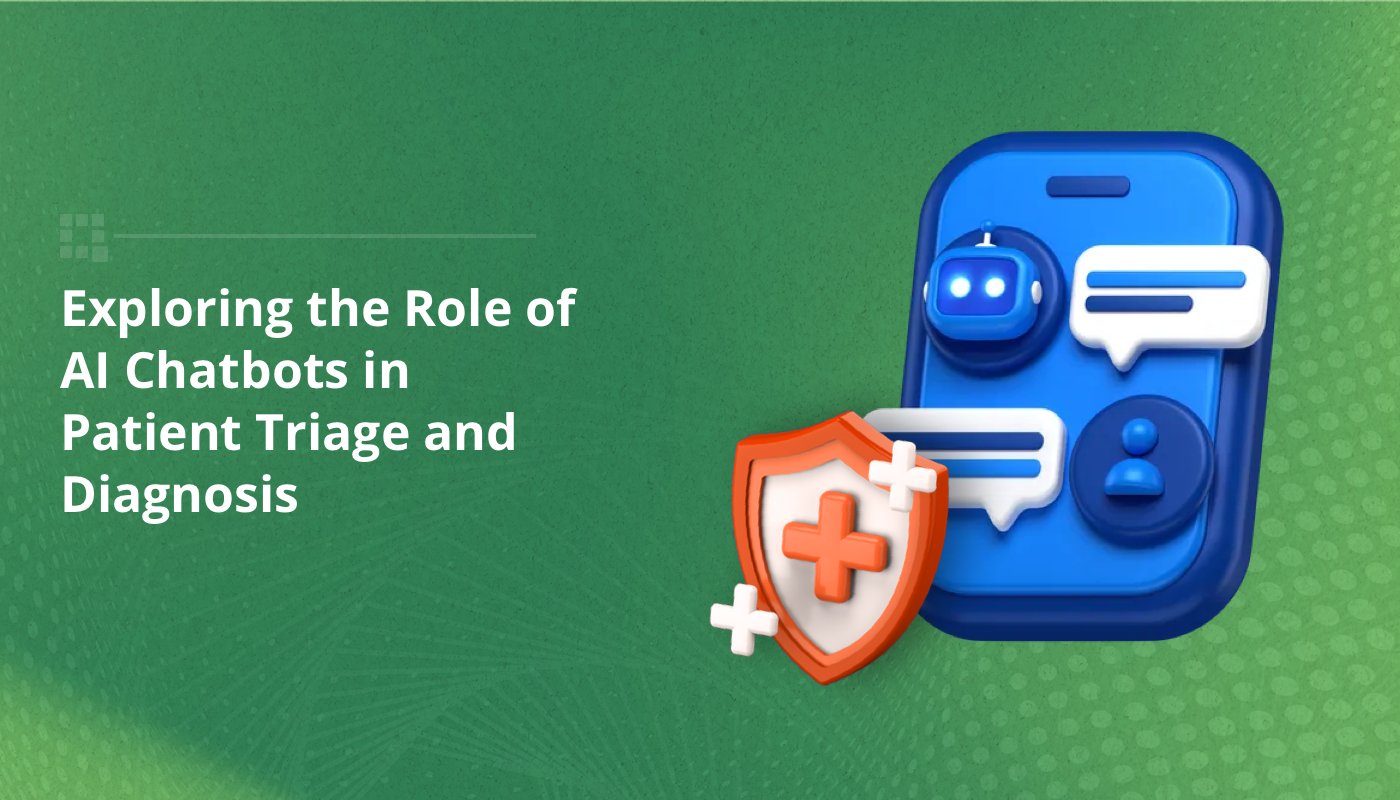
Summary: This blog explores the role of AI chatbots in patient triage and diagnosis. By using chatbots to gather symptoms and medical history, prioritize cases, and suggest diagnoses, healthcare systems can streamline workflows, improve efficiency, and offer patients 24/7 access to basic health information and guidance. The post also highlights limitations, but suggests how powerful AI conversational chatbot like SmartChat Assistant by QuickBlox can ultimately assist clinicians and medical staff.
Table of Contents
Introduction
AI-powered chatbots have a significant role to play in streamlining patient triage and diagnosis. New research indicates that AI chatbots “are able to provide patients with triage and diagnostic information with a level of clinical accuracy and safety comparable to that of human doctors.” While a group of researchers at Yale School of Public Health have recently developed an AI platform for patient triage that can forecast both the length of a patient’s hospital stay and the severity of their illness during a viral outbreak.
These studies demonstrate that the implications for using AI chatbots in triage and diagnosis are far reaching. From mitigating staff burn out and shortages, enhancing accuracy and efficiency, to preventing unnecessary trips to the doctor, AI chatbots provide significant benefits. However, as with all new technologies it is important to acknowledge and address potential limitations. AI can greatly assist doctors and medical staff, but cannot replace them.
In the following, we’ll look more closely at the potential benefits, limitations, and the future of AI-powered triage and diagnosis assistants.
Chatbots in Healthcare
The application of AI to healthcare has long been studied by health tech companies. The arrival of conversational AI –exemplified by applications like ChatGPT–with its ability to engage in natural, human-like conversation, acted as a catalyst sparking further innovation. Hospitals and health tech firms have been investigating how AI-powered chatbots can improve the healthcare system while adhering to HIPAA regulations and maintaining safety and ethics.
Although there are many AI-powered healthcare applications being developed, AI-assisted patient triage and diagnosis is an especially promising area. As a first point of contact, these virtual assistants can provide direction and assistance in patient triage, which is the process of determining the urgency of a patient's condition and pointing them in the direction of the most suitable level of care. AI chatbots have the unique ability to help people understand, manage, and get care for their symptoms—that is, if they are trained on the appropriate data.
Learn more about, Enhancing Healthcare Communication with Generative AI
The Power of AI Chatbots in Triage
Traditionally, triage involves a phone call with a nurse or a visit to a walk-in clinic or emergency room (ER). Patients might have to wait several hours in a crowded waiting room before they can be seen by a doctor.
However the rise of AI chatbots can now streamline this process. Many hospitals have begun to offer symptom checkers on their websites, powered by AI algorithms. Tools, like Ada and buoy, can help patients assess their symptoms from the comfort of their homes and guide them towards the appropriate department or level of care.
AI chatbots can be programmed to ask a series of targeted questions about a patient’s symptoms and medical history. They obtain crucial information from the patient, such as the type, intensity, and duration of symptoms, much like an experienced triage nurse. A patient’s medical history and other demographic information are also taken into account. Through the application of advanced algorithms to analyze the responses, the chatbot is able to determine the urgency of the issue. This evaluation allows the chatbot to provide patients with a variety of options, including self-care guidance for mild problems, appointment scheduling for non-emergencies, or even a recommendation to seek emergency care if the condition looks serious.
The benefits of AI-powered triage are multi-fold:
Improved Accessibility: Notably, these intelligent bots are not confined to the boundaries of a workday, they operate 24/7, ensuring no patient is left unattended during a potential health crisis.
Instant Care: Patients can receive immediate guidance without waiting on hold or scheduling appointments for minor concerns, which can greatly reduce anxiety and frustration.
Streamlined Triage Process: Chatbots can efficiently collect patient information and symptoms through a user-friendly interface, potentially reducing wait times and improving patient experience.
Enhanced Efficiency: Automating routine triage tasks with AI chatbots can free up healthcare professionals’ time to focus on more complex cases.
Reduced Emergency Room Visits: Chatbots can accurately direct patients towards self-care options, scheduling appointments, or seeking immediate care if necessary, thereby optimizing hospital resources and potentially reducing unnecessary ER visits.
Personalized Initial Assessments: Some AI chatbots can consider a patient’s age, sex, and medical history to personalize initial symptom assessments.
Standardized Data Collection: AI chatbots ensure consistent data collection through predefined question sets, improving data quality for further analysis.
Encourage Patient self-empowerment: By offering readily available medical advice, AI chatbots could empower patients to take a more proactive role in managing their own health.
AI for Diagnosis
Outside of triage, AI chatbots are proving a useful tool for aiding diagnosis. In addition to analyzing patient-reported symptoms through natural language processing (NLP) techniques, these chatbots can also access vast medical databases and utilize machine learning algorithms to identify potential diagnoses based on the information gathered. This allows them to generate a list of preliminary diagnoses, highlighting the most likely causes of the patient’s symptoms based on statistical probability. Early research suggests a high level of accuracy in AI’s diagnostic ability.
Learn more about, How AI ChatBots Work: A comprehensive Guide
It’s crucial to remember that AI chatbots are not designed to replace doctors’ judgment. The human element remains irreplaceable in medical diagnosis. A doctor’s expertise, honed through years of training and experience, is invaluable in interpreting complex symptoms, conducting physical examinations, and considering a patient’s unique medical history. However, AI chatbots can be a powerful tool to assist doctors in the diagnostic process, acting as an intelligent assistant rather than a replacement.
Here’s how AI healthcare chatbots can help clinicians
Initiate the diagnosis process: They can provide healthcare professionals with a starting point for further evaluation. This can be particularly helpful for initial assessments, allowing doctors to prioritize cases and optimize their time.
Utilize complex diagnostic techniques: AI excels at certain diagnostic approaches that clinicians can struggle with. For example, AI’s strong ability in probabilistic reasoning, a highly complex component of diagnosis that involves the calculation of odds, renders it a highly “useful clinical decision support tool for physicians.”
Access a larger database: Furthermore, AI chatbots can analyze vast amounts of medical data that may not be readily accessible to a single doctor, potentially leading to a more comprehensive understanding of a patient’s condition.
Provide on-going evaluation: Furthermore, the role of AI chatbots extends beyond the primary diagnosis. They can assess the patient’s condition over time, making them great tools for follow-up. They can constantly monitor the patient’s responses to treatments, track symptom progression, and offer course corrections when necessary.
Navigating the Challenges of AI Chatbots in Triage and Diagnosis
While AI chatbots offer exciting possibilities for patient triage and diagnosis, it’s essential to acknowledge their limitations and the important considerations for responsible development and implementation.
Data Dependence and Accuracy: The accuracy of AI diagnoses heavily relies on the quality of data used to train the algorithms. Developers must prioritize the use of high-quality, diverse datasets to ensure fair and accurate diagnoses across different demographics.
Physical Examination Limitations: Current AI chatbots lack the ability to perform physical examinations, such as assessing vital signs or observing physical characteristics, which is a crucial element in medical diagnosis. The integration of wearable data-collecting devices or other technologies in the future could potentially address this limitation, but for now, human intervention remains essential.
Ethical Considerations and Bias: Ethical considerations around bias in AI algorithms are a major concern. Biases present in the training data can lead to unfair or inaccurate diagnoses for certain populations. Developers must actively identify and mitigate potential biases to ensure AI chatbots provide equitable care for all users.
Data Security and Privacy: The sensitive nature of patient health information necessitates robust data security measures. Developers must ensure compliance with data privacy regulations and implement strong encryption protocols to protect sensitive user data from breaches or unauthorized access.
Transparency and Explainability: The “black box” nature of some AI algorithms can make it difficult to understand how they arrive at a particular diagnosis. For both patients and healthcare providers, transparency in the AI decision-making process is crucial. Developers should strive for explainable AI models that can provide insights into the rationale behind the chatbot’s recommendations.
Human Oversight and Regulation: Despite advancements, AI chatbots must not be viewed as a replacement for qualified healthcare professionals. Human oversight and judgment remain essential in the diagnostic process. Regulatory frameworks need to be established to ensure the safe and ethical development and deployment of AI chatbots in healthcare settings.
Learn more about, How Digital Communication is Changing Home Healthcare
Assistance rather than Replacement
By acknowledging these limitations and considerations, developers can work towards creating responsible and effective AI chatbots that complement, rather than replace, human expertise in patient triage and diagnosis. For example, building chatbots that offer human handover capabilities is essential. This means that patients can experience seamless interaction with a healthcare organization, with a chatbot conducting the initial triage before handing over to a human agent as and when appropriate.
Collaboration is key to the future of AI in diagnosis and triage. AI chatbots can be effective assistants, freeing up doctors’ time for critical thinking and complex cases. However, professionals still have the last say when it comes to diagnosis and treatment recommendations.
Conclusion: Unlocking the Potential of AI Chatbots in Healthcare
For developers seeking to integrate AI chatbots into their healthcare applications, platforms like QuickBlox offer a secure and reliable solution. QuickBlox’s SmartChat Assistant for healthcare is a HIPAA-compliant AI chatbot specifically designed for secure communication. It provides robust data encryption, human handover capabilities, and a user-friendly interface for building and customizing chatbots. Additionally, QuickBlox’s platform allows developers to tailor the chatbot’s knowledge base to their specific needs, ensuring it leverages the most relevant and up-to-date medical information.
Talk to a sales expert
Learn more about our products and get your questions answered.
Contact sales








